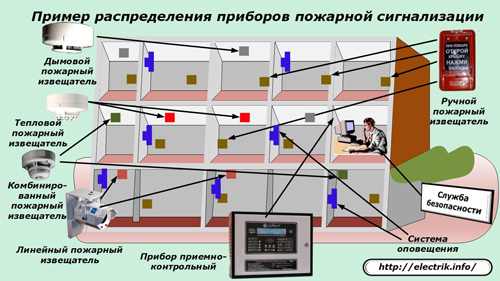Categories: How does it work
Number of views: 88653
Comments on the article: 0
How the fire alarm is arranged and works
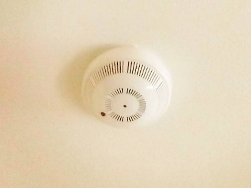 Even in ancient times, people used the transmission of information about the beginning of the occurrence of certain events to a distance in the form of light signals or clearly audible sounds, when bonfires were made on the hills or bells were rung.
Even in ancient times, people used the transmission of information about the beginning of the occurrence of certain events to a distance in the form of light signals or clearly audible sounds, when bonfires were made on the hills or bells were rung.
The life of a modern person is connected with the operation of a large number of various equipment, the work of which is often monitored remotely using various types of signaling. Among them, information on the onset of a fire at critical industrial facilities and inside multi-story buildings with a large number of people is given crucial importance.
Fire alarm purpose
Its main task is to ensure that, at the first signs of a fire, information is quickly transferred to the duty service, which is able to quickly arrive at the scene and take emergency measures to extinguish the fire, and prevent its spread.
Additional tasks of fire alarm systems (ATP) can be:
-
remote activation of pre-arranged fire extinguishing means - various types of fire extinguishers, created in relation to the specific conditions of production or facility;
-
ensuring the unlocking of access control control systems to facilitate the mass evacuation of people from a dangerous place;
-
information transfer to additional dispatch control points;
-
other functions.
Fire Alarm Composition
The fire alarm system is considered as a specific electrical control system, the circuit of which consists of various parts:
-
special sensors - announcers reporting the start of a fire;
-
channels for transmitting signals about the operation of the sensor;
-
control panels, reception (PKP) and information display for operational personnel;
-
public address systems.
How fire detectors are arranged and work
You can evaluate the occurrence of the first signs of fire by the appearance of smoke, rapid heating of the environment or a strong flash of light. These three factors are laid down in the principle of operation of various technical devices.
In the industrial and residential sectors, four types of sensors operating on various principles are most widely used:
1. detection of the beginning of the spread of smoke - smoke detectors;
2. the appearance of sharp heating indoors - thermal;
3. The allocation of electromagnetic waves in the optical range of the visible, ultraviolet or infrared spectrum - flame;
4. simultaneous exposure to heat and smoke, and often in combination with the appearance of bright light - combined.
Fire alarm sensors can only monitor the state of a monitored parameter or react to its change by issuing a signal to an external system. According to this principle, they apply not only to passive, but also to active devices. Detectors can be created to control a specific local area or an extended, elongated space. Recent designs are called linear.
The principle of operation of smoke detectors
The sensor is placed on the ceiling in the place where the smoke rises and begins to concentrate when the fire starts.
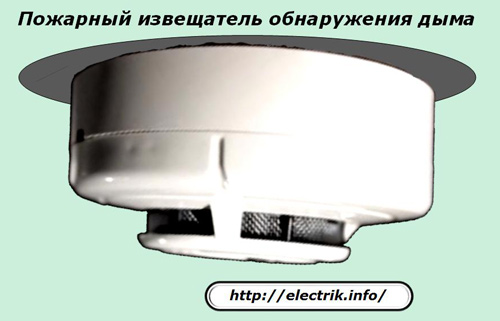
Structurally, the smoke detector consists of:
1. split housing;
2. electronic board;
3. optical system.
These parts are individually assembled on automated production lines and, after passing various tests and checks, are manually assembled into a single module.

The operation of the sensor is based on fixing the moment of smoke in its housing due to the operation of the optical system, which includes:
-
Light-emitting diodeemitting a strictly directed beam of light;
-
photocell, which converts the incident light flux into an electric signal.
Structurally, the light beam from the source is directed slightly away from the photocell. Under normal operating conditions with the normal state of the air in the room, the light cannot reach the surface of the photocell, as shown in picture No. 1.
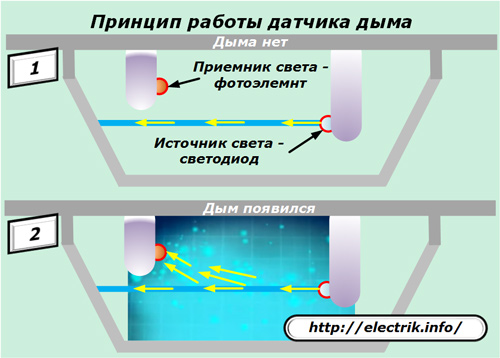
In the event of smoke in the sensor housing, the reflection of light rays in all directions begins. They get on the photocell, and it works. This moment is controlled by an electronic circuit. It forms an information command, transmits it via communication channels to a fire alarm receiving device.
If water vapor or gases deflecting the light flux penetrate into the sensor cavity, the photocell will also work, and the logic circuit will give false information about the occurrence of a fire.
For this reason, smoke detectors are not installed in places where they are capable of malfunctioning. These include kitchens, bathrooms, showers. Installation of smoke detectors in places where smokers gather will also cause their frequent and false work.
Such a fire detector will not respond to a rise in temperature and a flash of light from an open flame. Therefore, such modules are installed in those rooms where ignition is associated with smoke from the environment from thermal damage to the insulation of electrical wires, fabrics, and other similar materials.
They are installed in places with a large number of working electrical equipment in industrial production, warehouses for storage of material assets, electrical substations and laboratories.
Principle of operation of heat detectors
They are also located on the ceiling, where the heat generated by open fire rises. They can work by factor:
1. achieving the maximum allowable heating value;
2. The rate of temperature increase.
Threshold devices
Sensors of this type began to be created very first. Initially, they worked due to the leakage of a fusible alloy from a fuse installed at the contact point of two conductors. Due to this, when the environment was heated to 60–70 degrees, the electric circuit broke and a signal was issued about the start of a fire.
The principle of operation of one of such designs of a disposable, non-recoverable heat detector of the IP-104 type is shown in the picture.
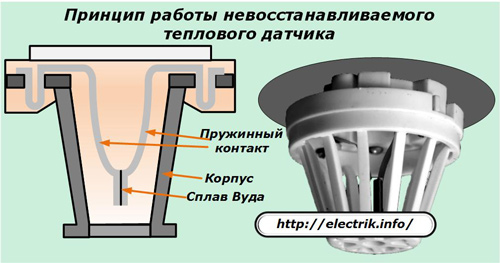
Inside the case there are spring contacts, which are diverted from each other by mechanical tension, and are held by the Wood alloy, consisting of low-melting metals. The sensor is triggered when heated to 68 degrees, and cocked springs provide a chain break.
Similar designs are constantly being improved. Now they are available with replaceable swimming trunks inserts or elements controlled from a distance. The logic circuit can be performed on different principles and electronic components.
Integrated Detectors
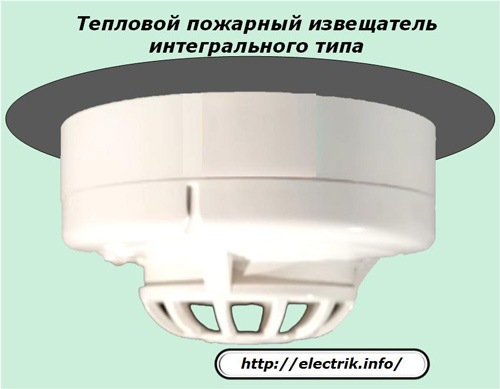
The sensor is based on measurements of the rate of change in the electrical resistance of metals when they are heated.
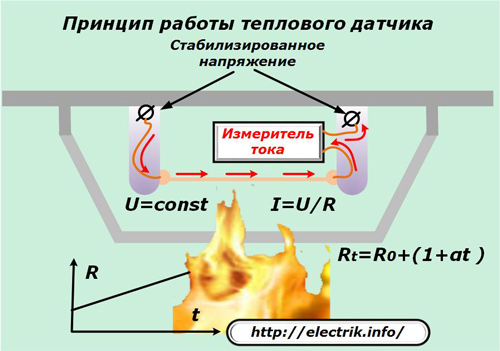
A stabilized voltage is applied to the terminals of the thermal control element from the power source. Under its action, a current, determined by Ohm's law, flows in an electric circuit through a wire resistor and a measuring device. Its value strictly depends on the resistance.
Under the influence of ordinary room temperature, its value remains almost unchanged. At a stabilized voltage, the current also does not change.
When the temperature of an open flame begins to act on the control element from the flame that has appeared, the resistance of the sensor begins to increase rapidly and, according to the same law, the current begins to change. The speed of its deviation from the previously established value is fixed by an electronic circuit, which is usually configured to increase 5 degrees per second.
When a critical value of the heating rate is reached, the sensor logic circuit sends a signal to the receiving module via communication channels.
In this circuit there are no devices that respond to smoke, and it will not work on it.
Such designs work most effectively in fires caused by the ignition of combustible liquids from petroleum products, carbon fuels, and fire hazardous solid materials. They are installed in places of storage of containers with flammable liquids, warehouses of building materials and in similar industrial buildings.
The principle of operation of flame detectors
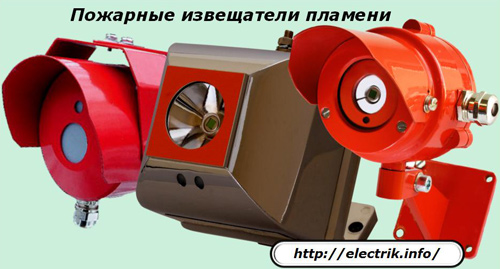
A fairly large class of these sensors react to open fire or a smoldering fire without causing smoke.
A sensitive photocell detects the appearance of one of the spectra of optical waves or its full range. At the same time, the design is quite complicated and expensive. For this reason, they are not used in residential buildings, but are used in enterprises of the oil and gas industry.
The simplest models of this type are able to operate from the effects of the welding arc, the light of the bright sun, fluorescent lamps, electromagnetic interference of the optical spectrum. Various filters can be used to eliminate false operation.
Principle of operation of combined detectors
All designs of fire detectors that operate on any one sign of fire can falsely work. To expand the reliability limit of the transmitted information, devices are created that immediately combine the capabilities of smoke and thermal models, or are supplemented with a flame reaction function.
To do this, they immediately include an infrared, thermal and optical sensor. They can in most cases be configured to operate on each input parameter separately or only when they appear simultaneously.
For critical industrial premises, there are four-channel combined detectors that additionally take into account the appearance of carbon monoxide.
The principle of operation of manual fire detectors
The simplest designs from an ordinary spring-reset button are used to manually alert operational workers about the start of a fire. For this, personnel who notice the onset of signs of fire, just open the protective cover and press the button.
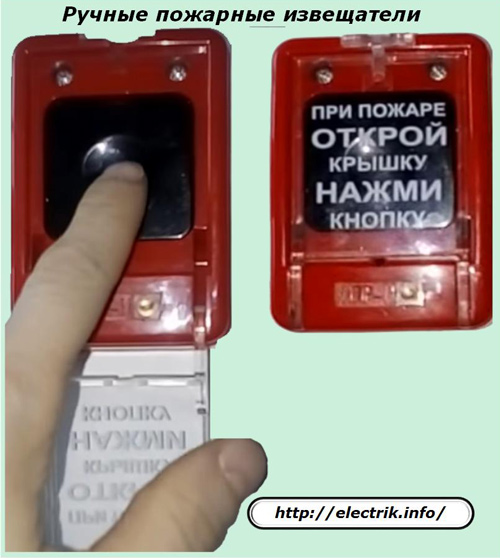
With this action, the circuit contacts are closed and the “Fire alarm” alert is activated. When the button is released, the signal is not interrupted: its power supply chain is automatically set to self-locking. Warning of people about fire hazard will occur until the responsible employee unlocks it with a special key.
Such hand-held sensors are mounted in all rooms where masses of people gather (shops, hospitals, cinemas, industrial facilities) at a height of one and a half meters and at a distance of up to 50 m between them.
Brief conclusions on the choice of fire detectors
The design and principle of operation of the sensor should be as appropriate as possible to ensure fire safety of the controlled room.
In large industrial buildings with different equipment, it is not always advisable to use the same brand of detectors, and their number, even with limited financial capabilities, should cover all hazardous fire zones in accordance with the requirements of regulatory documents.
Detector alarm channels
After the types and number of fire detectors are determined for indoor installation, they are connected by wires to the cables, which are collected on the control panel in the operational security service.
For loops, choose wires with copper conductors and lay them with the possibility of providing control of the technical condition.To them SNIP and GOST impose requirements on the methods of separate laying with other cable lines and to provide protection against mechanical damage.
Devices for receiving and monitoring signals
Control panels are created by manufacturers of varying degrees of complexity for professional, semi-professional or domestic use.
Professional devices designed to address not only fire safety issues, but also the protection of facilities. They are:
-
monitor the state of multipath circuits and are capable of simultaneously processing analog and digital signals;
-
allow cascading into blocks to create a complex hierarchy of control schemes;
-
they are connected to the computer of the fire and security service;
-
record in time and transmit all the information occurring at the controlled object;
-
used only at critical industrial facilities.
Semi-professional devices work with digital signals. They are made in a single case, combining:
-
power supply from a stationary electrical network;
-
backup power source - a powerful battery that can provide autonomous operation of the system from several hours to a day;
-
electronic control unit;
-
CPU.
At critical sites, the processor is protected from unauthorized access by placing it in hard-to-reach places with full shielding, which prevents hacking attempts with a special remote scanner, and complex encoding of the processed and transmitted information.
Such models are capable of processing signals from two hundred and fifty sensors. They can already be used in the residential sector.
Multipath household control panels
They are created for work in a private household with various outbuildings.
Able to process signals from electrical contacts of reed switches or electronic circuits, as well as information received via wireless channels from two to eight different sources.
The simplest apartment control panels
They are represented by the simplest models operating in a single-channel mode, which is quite enough for the owner of the apartment. Even such a device is capable of transmitting information about the operation of sensors to the host’s mobile phone in the form of SMS.
Control panels designed for domestic purposes are accompanied by detailed technical documentation from the manufacturer with instructions and wiring diagrams. For them, the European standard EN54 is introduced.
Fire warning systems
In crowded buildings, a light and sound warning system for personnel and visitors is used by the “Alarm” command alert. At the same time, information is transferred to the management of the enterprise and the emergency services for taking emergency measures.
An example of the distribution of various fire alarm devices and the organization of a warning system is shown in the picture.
Like all technical devices, fire alarms require periodic monitoring and health checks, a set of maintenance measures, settings, and adjustments. In this case, the rules for their operation must be observed.
I would like to express my confidence that the initial information presented on the device of a modern fire alarm system will give the reader an idea: in practice, create for yourself an optimal system that excludes fire in the event of accidental fire or deliberate arson.
See also at bgv.electricianexp.com
:

